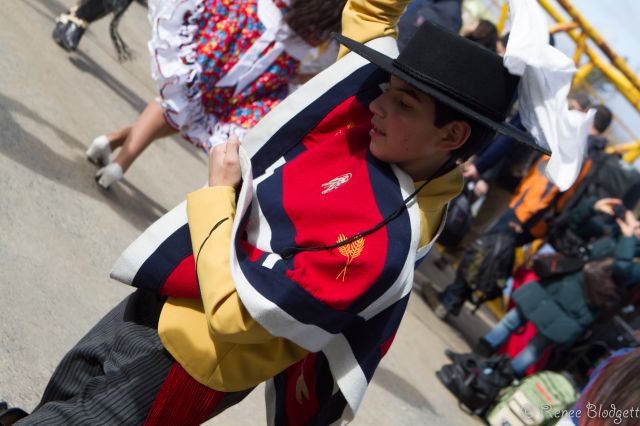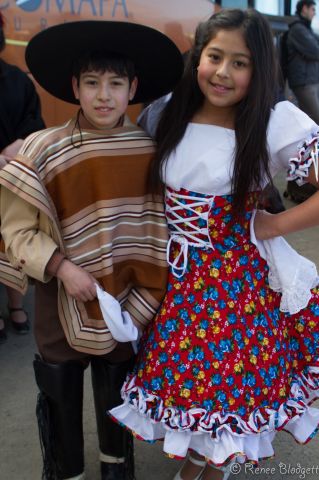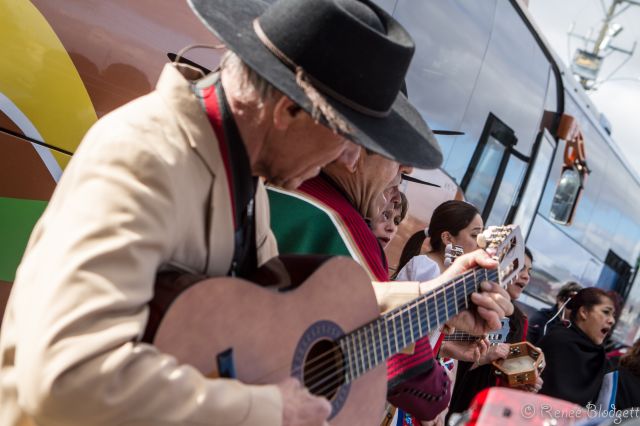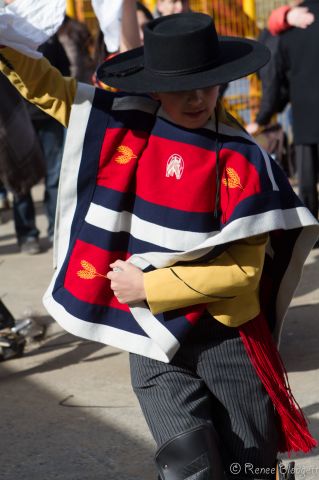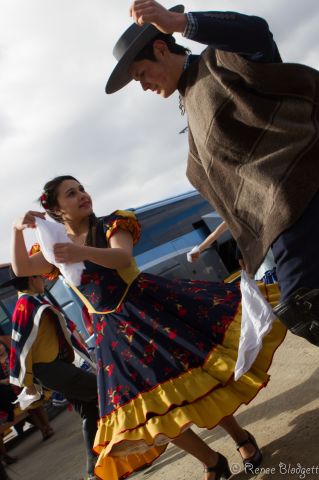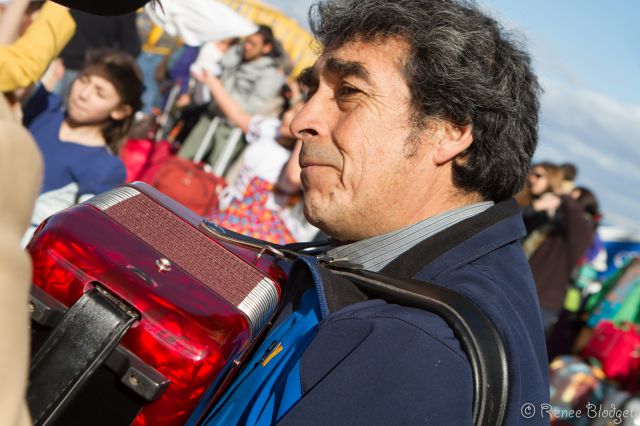Chileans celebrate ancestral rituals through, among other cultural activities, folk dancing. In the north they celebrate the Fiesta de La Tirana; in the south it may be the nguillatún, a Mapuche ritual; on Easter Island it is the sau sau, their popular dancesong, and throughout the country, the national dance called la cueca, in which a couple wave handkerchiefs in the air and represent the romantic playfulness of courting.
Dance is the expression of popular piety and is part of the pagan festivals inherited from the Incas. A manifestation of syncretism with Catholic culture is the diablada of the Fiesta de la Tirana. This is the dance of religious brotherhoods in which some dancers wear demonic masks, while their accompanying musicians, attired in colorful costumes, play percussion and wind instruments. Above and below I watched a dance performed by children as we disembarked from our ship in Puerto Natales along the coast in southern Chile.
In addition to the cueca which is danced and sung especially during the national independence celebrations, another courtship dance is the sombrerito, in which the woman holds a hat aloft instead of a handkerchief and approaches or moves away from her partner, mixing slow steps with quick, staccato ones. At the end of this courtship dance, the couple hide their faces behind the hat and simulate a kiss.
In the south, Mapuche dance is a ritual of worship rendered to the divinity and a healing ceremony as well. In the nguillatún and the machitún, prayers are offered to the supreme god Ngenechen and to the rehue or canelo tree (Drimys winteri), sacred to this culture. There is also the loncomeo, which means “to move the head.” It is a dance that imitates the movements of animals around the fire in the central hearth, or fogón. The presence of the machi, the shamanness of the Mapuches, is fundamental in these ritual dances, as she is the sole intermediary between mortals and the spirit world. A special occasion for feasting and dancing is, of course, the new year of the Mapuches, We Tripantu.
Among fishermen and farmers, the steps and choreographies are livelier, as though to shake away the cold. In the trastasera the man moves his arms, inviting the woman, who takes a corner of her skirt in her hand, to make una media vuelta or a half turn until she faces him. In the costillar two men compete, dancing around a bottle placed in the middle of the dance floor, and the one who kicks the bottle over loses.
Other couple dances are the vals chilote, in which the woman and the man increasingly intensify the forcefulness of their steps; the sirilla, which originated in the Spanish dance called the seguidilla, and the zamba refalosa, a typical dance from the island of Achao.
Influences
The Chiloé Island dance sirilla has Spanish influences, while the tamuré of Easter Island is of Tahitian origin, and many other typical Chilean dances trace their original influences from other lands and cultures as well. The refalosa originated in Peru, the cuando from Spain, the rhythms of the peasant dance guaracha are the legacy of Colombian and Cuban dance, the polka came from Central Europe, and the corrido is typically Mexican.
While the children danced, the adults played instruments and we all tapped along on that glorious September afternoon against a cloudy Patagonia sky.

Renee Blodgett is the founder of We Blog the World. The site combines the magic of an online culture and travel magazine with a global blog network and has contributors from every continent in the world. Having lived in 10 countries and explored nearly 80, she is an avid traveler, and a lover, observer and participant in cultural diversity.
She is also the CEO and founder of Magic Sauce Media, a new media services consultancy focused on viral marketing, social media, branding, events and PR. For over 20 years, she has helped companies from 12 countries get traction in the market. Known for her global and organic approach to product and corporate launches, Renee practices what she pitches and as an active user of social media, she helps clients navigate digital waters from around the world. Renee has been blogging for over 16 years and regularly writes on her personal blog Down the Avenue, Huffington Post, BlogHer, We Blog the World and other sites. She was ranked #12 Social Media Influencer by Forbes Magazine and is listed as a new media influencer and game changer on various sites and books on the new media revolution. In 2013, she was listed as the 6th most influential woman in social media by Forbes Magazine on a Top 20 List.
Her passion for art, storytelling and photography led to the launch of Magic Sauce Photography, which is a visual extension of her writing, the result of which has led to producing six photo books: Galapagos Islands, London, South Africa, Rome, Urbanization and Ecuador.
Renee is also the co-founder of Traveling Geeks, an initiative that brings entrepreneurs, thought leaders, bloggers, creators, curators and influencers to other countries to share and learn from peers, governments, corporations, and the general public in order to educate, share, evaluate, and promote innovative technologies.

